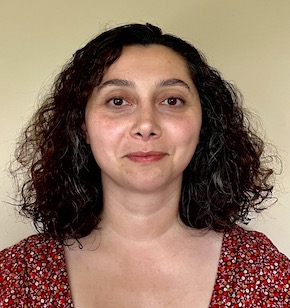|
Contact information |
 |
Education and Work experience
Staff Scientist, Lawrence Livermore National Laboratory (Jan 2024 – Present)
Postdoctoral researcher, Lawrence Livermore National Laboratory (Sept 2022 – Jan 2024)
Postdoctoral researcher, Washington University in St Louis, Department of Biochemistry and Molecular Biophysics (Dec 2019 – Sept 2022)
PhD, Physics, Concordia University (Aug 2014 – Sept 2019)
MSc, Computational Sciences and Engineering, Koç University (Sept 2012 – Aug 2014)
BSc, Istanbul Technical University, Physics Engineering (Sept 2006 – Jun 2011)
Research
I use computational modeling to study the within-membrane assembly of membrane proteins. I'm also interested in studying how lipids modulate function, conformational dynamics and association of these proteins. Biophysics education is an additional interest of mine.
Publications
|
[14] TN Ozturk, M Konig, TS Carpenter ,KB Pedersen, TA Wassenaar, HI Ingólfsson, SJ Marrink (2024). Building complex membranes with Martini 3. Methods in Enzymology. (In press, online version can be found at https://doi.org/10.1016/bs.mie.2024.03.010) |
|
[13] L Borges-Araújo, A Borges-Araújo, TN Ozturk, DP Ramirez-Echemendia, B Fábián, TS Carpenter, S Thallmair, J Barnoud, HI Ingólfsson, G Hummer, DP Tieleman, SJ Marrink, PCT Souza, MN Melo. (2023). Martini 3 Coarse-Grained Force Field for Cholesterol. Journal of Chemical Theory and Computation, 19(20), 7387-7404 |
|
[12] TN Ozturk*, N Bernhardt*, N Schwartz, R Chadda, JL Robertson and JD Faraldo-Gomez. (2023). Mitigation of membrane morphology defects explain stability and orientational specificity of CLC dimers, BioRxiv, DOI: 10.1101/2023.03.16.533024 |
|
[11] M Ernst, TN Ozturk, JL Robertson. (2023). A single-molecule method for measuring fluorophore labeling yields for the study of membrane protein oligomerization in membranes. PloS one 18(1), e0280693 |
|
[10] TN Ozturk, C. Coumoundouros, D. Culham and J. Wood. (2023). Structural determinants and functional significance of dimerization for osmosensing transporter ProP in Escherichia coli. Biochemistry 62(1) 118-133 |
|
[9] S Ahrari, TN Ozturk, N D’Avanzo. (2022). Ion behaviour in the selectivity filter of HCN1 channels. Biophysical Journal 121 (11), 2206-2218 |
|
[8] EA Orabi, TN Öztürk, N Bernhardt, JD Faraldo-Gómez. (2021). Corrections in the CHARMM36 Parametrization of Chloride Interactions with Proteins, Lipids, and Alkali Cations, and Extension to Other Halide Anions. Journal of Chemical Theory and Computation 17 (10), 6240-6261 |
|
[7] K Mersch, TN Ozturk, K Park, HH Lim, JL Robertson. (2021). Altering CLC stoichiometry by reducing non-polar side-chains at the dimerization interface. Journal of Molecular Biology 433 (8), 166886 |
|
[6] R Chadda, N Bernhardt, EG Kelley, SC Teixeira, K Griffith, A Gil-Ley, TN Öztürk, LE Hughes, A Forsythe, V Krishnamani, JD Faraldo-Gómez, JL Robertson. (2021). Membrane transporter dimerization driven by differential lipid solvation energetics of dissociated and associated states. Elife 10, e63288 |
| [5] TN Ozturk, DE Culham, L Tempelhagen, JM Wood, G Lamoureux. (2020). Salt-Dependent Interactions between the C-Terminal Domain of Osmoregulatory Transporter ProP of Escherichia coli and the Lipid Membrane. The Journal of Physical Chemistry B 124 (38), 8209–8220 |
| [4] L Krohn*, TN Öztürk*, B Vanderperre*, B Ouled Amar Bencheikh, JA Ruskey, … (2020). Genetic, Structural, and Functional Evidence Link TMEM175 to Synucleinopathies. Annals of Neurology 87 (1), 139–153 |
| [3] DE Culham, D Marom, R Boutin, J Garner, TN Ozturk, N Sahtout, L Tempelhagen, G Lamoureux, and JM Wood (2018). Dual role of the C-terminal domain in osmosensing by bacterial osmolyte transporter ProP. Biophysical Journal 115 (11), 2152–2166 |
| [2] TN Ozturk, S Keskin. (2014). Computational screening of porous coordination networks for adsorption and membrane-based gas separations. The Journal of Physical Chemistry C 118 (25), 13988–13997 |
| [1] TN Ozturk, S Keskin. (2013). Predicting gas separation performances of porous coordination networks using atomistic simulations. Industrial & Engineering Chemistry Research 52 (49), 17627–17639 |


